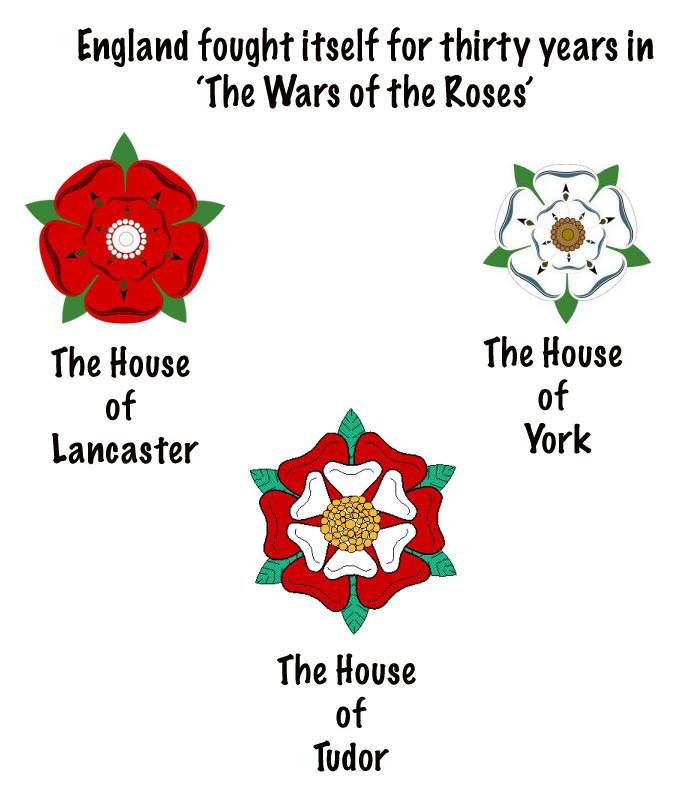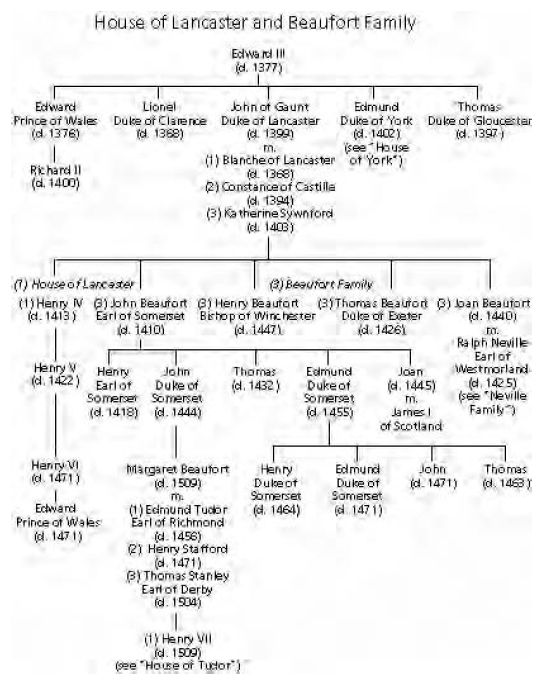- Lancaster, House of
- (1399–1461, 1470–1471)A branch of the royal family of PLANTAGENET, which had ruled England since 1154, the house of Lancaster and its partisans comprised one of the parties contending for the throne during the WARS OF THE ROSES. The family of Lancaster descended from John of Gaunt, duke of Lancaster (1340– 1399), the third son of Edward III (r. 1327– 1377). The Lancastrians became the ruling dynasty in 1399 when Henry of Bolingbroke, Gaunt’s son, deposed his childless cousin Richard II (r. 1377–1399) and assumed the Crown as Henry IV (see Richard II, Deposition of). Because Henry’s usurpation broke the normal line of succession, he spent much of his reign (1399–1413) quelling uprisings launched on behalf of the legal heirs, the Mortimers, who descended from Gaunt’s older brother, Lionel, duke of Clarence (1338–1368). However, Henry IV survived and in 1413 was peacefully succeeded by his son Henry V (r. 1413–1422), who secured the dynasty on the throne by reviving the HUNDRED YEARS WAR and uniting England against its ancient enemy, FRANCE. Henry’s victory at Agincourt in 1415 and his conquest of much of northern France intensified English pride in the king and his dynasty. On Henry V’s death in 1422, the Crown passed to a nine-month-old infant, HENRY VI, whose mother was Catherine of Valois, the daughter of Charles VI of France. By the 1420 Treaty of Troyes, Henry V was recognized as heir to the French Crown. Thus, upon Charles VI’s death in October 1422, Henry VI was proclaimed king of both England and France while still less than a year old. While the king’s eldest uncle, John, duke of Bedford (1389–1435), governed France and conducted the ongoing war as his nephew’s regent, a council of nobles under the nominal leadership of the king’s younger uncle, Humphrey, duke of Gloucester (1390–1447), governed England. In the 1450s, Henry VI, who was politically inept and easily led by favorites, fell victim to ongoing mental illness and proved himself unfit to rule (see Henry VI, Illness of). Royal weakness revived the long dormant claim of the Mortimers, now embodied in Richard PLANTAGENET, duke of York, whose mother had been a Mortimer. York was heir presumptive to the throne until the birth of Henry’s son, Prince EDWARD OF LANCASTER, in 1453. In the mid-1450s, York, believing himself excluded from the political power that was his right by birth, sought to govern on behalf of the stricken king. The Wars of the Roses erupted as nobles, seeking either to retain the influence they exercised as royal favorites, or, like York, to force their way into the circle of royal favor, formed factions around the king and the duke. Long-standing local feuds intensified the struggle, as rivals merged their quarrels into the national conflict. In 1460, York claimed the Crown outright, and in 1461, his son, EDWARD IV, overthrew Henry VI and set the house of YORK on the throne. Although Henry VI was briefly restored in 1470–1471, the death of his son at the Battle of TEWKESBURY led to the ex-king’s murder and the extinction of the direct male line of Lancaster in May 1471.Nevertheless, the Lancastrian claim to the Crown survived. Although Henry VI had no full siblings, and his uncles were childless, the dynasty had a collateral branch that figured prominently in the Wars of the Roses. In 1396, John of Gaunt had married his longtime mistress, Katherine Swynford (d. 1403). Richard II had then legitimated Gaunt’s children by Swynford under the name of Beaufort, although Henry IV later barred his half siblings from the succession. During Henry VI’s minority, the leading member of the BEAUFORT FAMILY was Henry Beaufort, cardinal-bishop of Winchester (c. 1376– 1447). During the Wars of the Roses, Edmund Beaufort and his sons Henry and Edmund, all successively dukes of Somerset (see entries for all under BEAUFORT), were leaders of the Lancastrian party. Although all three dukes of Somerset died in the civil wars, ending the male line of Beaufort in 1471, their cousin, Margaret BEAUFORT, survived and eventually transmitted the Lancastrian claim to the throne to the house of TUDOR.HENRY VII, Margaret Beaufort’s son and the first Tudor monarch, was the grandson of an obscure Welshman, Owen TUDOR, who in the late 1420s secretly married Queen Catherine, Henry VI’s widowed mother. The children of this union, Edmund TUDOR, earl of Richmond, and Jasper TUDOR, earl of Pembroke,were thus half siblings of Henry VI. The Tudors’ claim to the English Crown derived from Richmond’s 1455 marriage to Margaret Beaufort, and it was this claim that Margaret’s son realized in 1485, when, as the last male descendent of the Lancastrian and Beaufort lines, he defeated RICHARD III and overthrew the house of York. Henry then Richard II (left) surrenders his crown to Henry of Bolingbroke, who thereby becomes Henry IV, first king of the house of Lancaster in 1399. (Royal MS 18 E II. f. 401, British Library) symbolically ended the Wars of the Roses by marrying ELIZABETH OFYORK, Edward IV’s heir; their son, Henry VIII, a descendent of both Lancaster and York, peacefully succeeded to the throne in 1509.Further Reading: Allmand, Christopher, Henry V (Berkeley: University of California Press, 1992); Griffiths, Ralph A., The Reign of King Henry VI (Berkeley: University of California Press, 1981); Griffiths, Ralph A.,“The Sense of Dynasty in the Reign of Henry VI,” in Ralph A. Griffiths, ed., King and Country: England and Wales in the Fifteenth Century (London: Hambledon Press, 1991), pp. 83–101; Kirby, John Lavan, Henry IV of England (London: Constable, 1970); Storey,R. L., The End of the House of Lancaster, 2d ed. (Stroud, Gloucestershire, UK: Sutton Publishing, 1999); Wolffe, Bertram, Henry VI (London: Eyre Methuen, 1981).


Encyclopedia of the Wars of the Roses. John A.Wagner. 2001.
